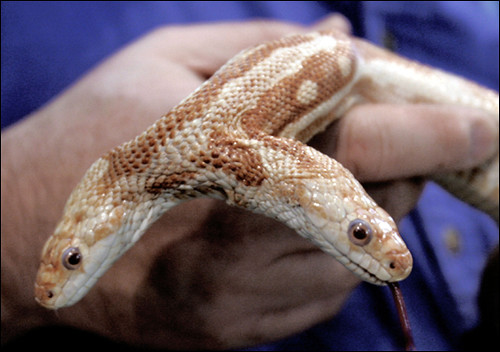tags: We, two-headed snake, reptile, World Aquarium
Leonard Sonnenschein, president of the World Aquarium in St. Louis, holds We, a two-headed albino rat snake. The snake came to the aquarium's attention when its previous owner distributed a circular offering it for sale days after its birth. The aquarium paid $15,000, knowing full well that most two-headed snakes don't live more than a few months.
[larger]
A rare two-headed albino rat snake, appropriately named "We," died this past weekend. The 8-year-old rat snake, the main attraction at the World Aquarium located inside the downtown City Museum in St. Louis, died of natural causes, said Leonard Sonnenschein. Sonnenschein is the president of the World Aquarium.
"It's terrible news," said a grieving Sonnenschein. "People come in every day and say: 'I'm here to see the two-headed snake.'" But disappointed people will not have long to wait before they can see We again: a taxidermist is preparing the snake's body, which should be back on display within one week.
More than one million people have seen We over the years. Children were especially mesmerized by the snake, especially when We sometimes struggled to move in two directions at the same time.
"These kinds of questions helped spur the science spirit in children," Sonnenschein observed.
We was purchased in 1999 from a snake breeder in Indiana for $15,000 when the snake was a only few weeks old. Last year the aquarium tried to auction We to raise money for research and conservation programs, asking $150,000, but none was crazy enough to buy a snake that might drop dead any minute. In fact, most two-headed snakes survive for only a week or two after birth.
We was a hermaphrodite, with both male and female genitalia. Last year, the World Aquarium tried unsuccessfully to breed We with another two-headed snake, and planned to try again this summer, aquarium spokesman David Isserman said.
I want to know, did they think that, by breeding two two-headed snakes to each other, would they produce a bunch of four-headed snakes?
Cited story.


How is motor control divided between the heads?
How is motor control divided between the heads?
Apparently not very well...
I want to know, did they think that, by breeding two two-headed snakes to each other, would they produce a bunch of four-headed snakes?
No, but they might have hoped to breed a conjoining-prone strain. That would be mighty interesting to developmental biologists.